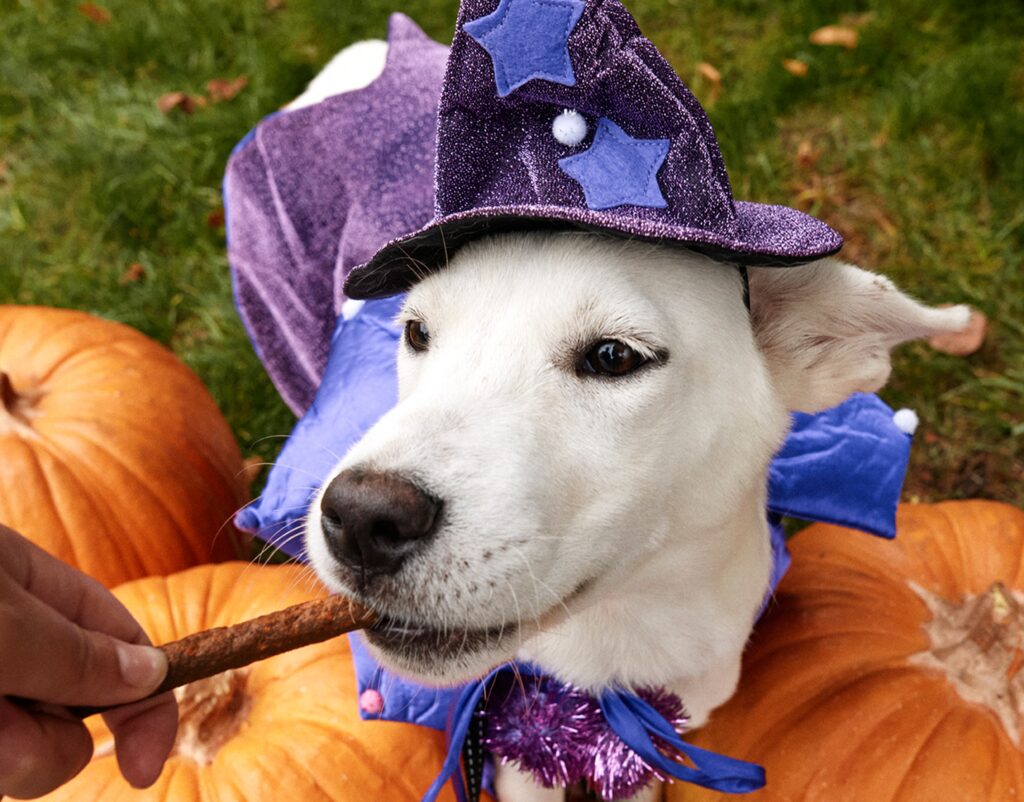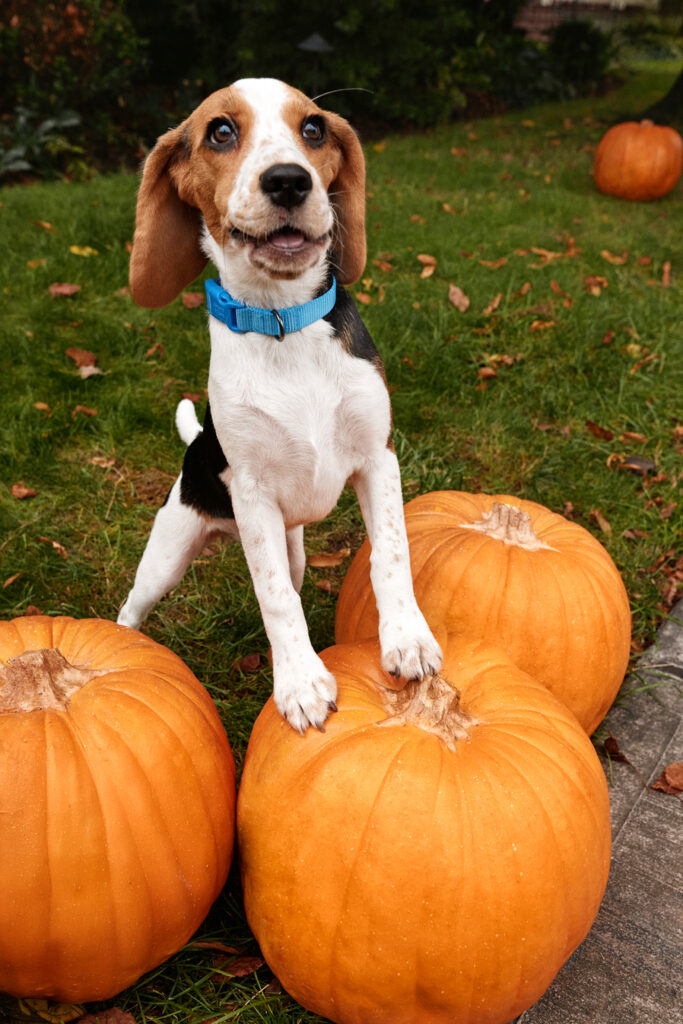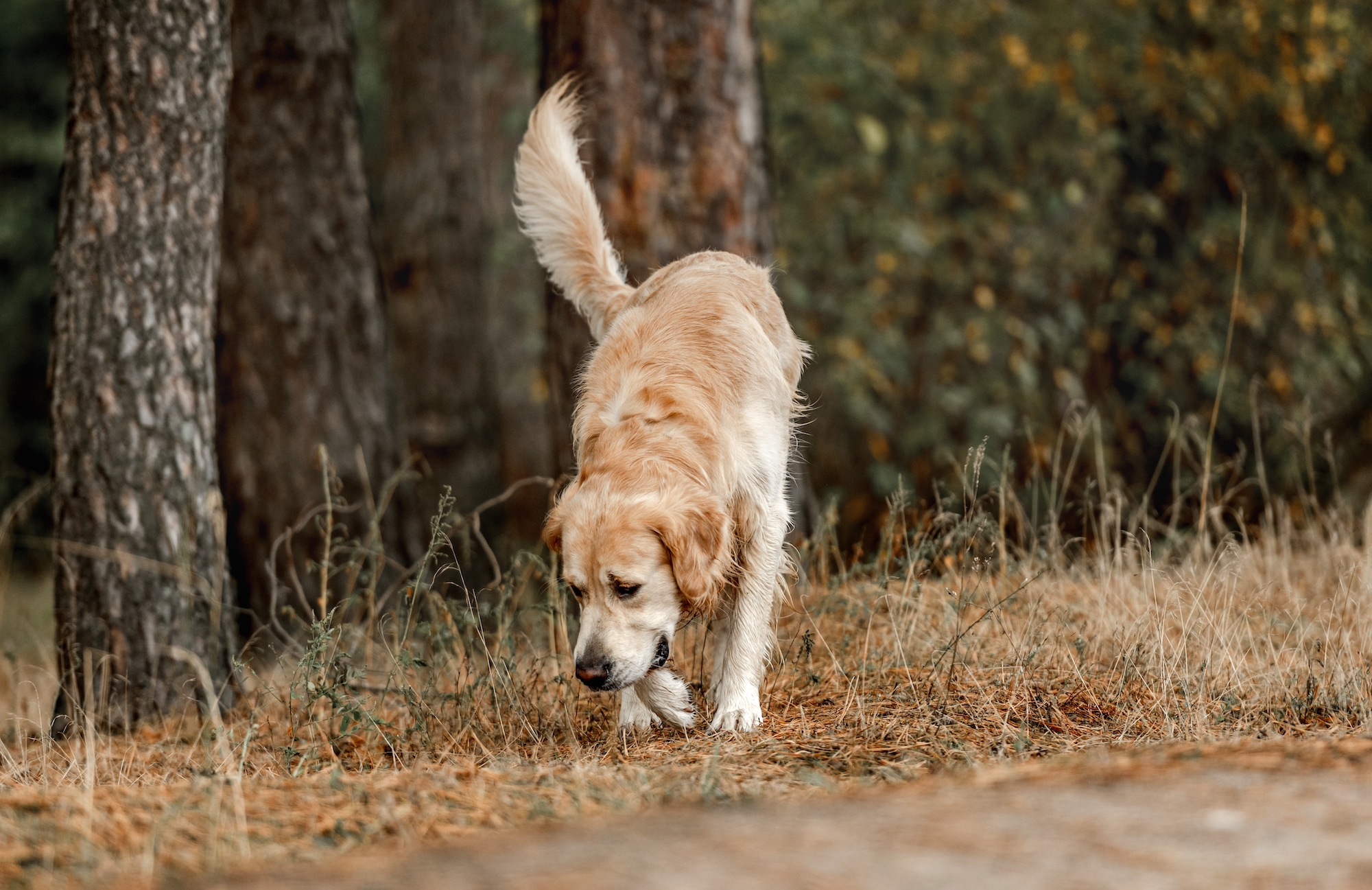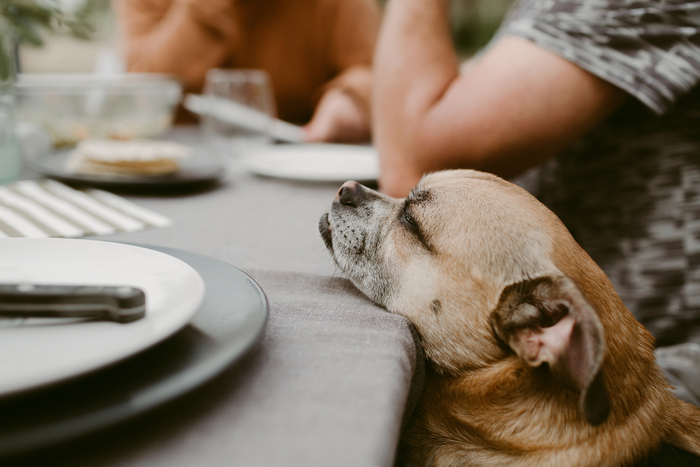In this article:
- Can my dog come trick-or-treating with me?
- How do I make a safe room for my dog?
- How can I manage door activity on Halloween?
- Should I update my dog’s identification before Halloween?
If you surveyed all the dogs in America on their least-favorite human holidays, we bet those with fireworks—like Memorial Day, the Fourth of July, and New Year’s Eve—would come first. But a runner-up might be Halloween. Sadly, dogs can’t give us their rankings directly, but we do know that they tend to dislike loud noises, flashing lights, and the sudden appearance of unusual forms, like your friendly neighborhood 12-foot skeleton.
Halloween’s combination of constant door activity, strange costumes, and overwhelming sensory stimulation can make even a usually calm dog anxious—or, worse yet, scare them into bolting. Here are expert tips on what you can do to keep your dog safe at home.
Think carefully before bringing your dog trick-or-treating
There are people who bring their dogs along with the family for trick-or-treating. For the above reasons, this generally isn’t recommended. But, as Brittnay Baumann, spokesman for the Animal Humane Society’s Minnesota chapter, said, “If you intend to take your dog out trick-or-treating with the kids, make sure to have them on a leash and under an adult’s control.”
Dogs can get loose, fight with other dogs, snap at costumed children, or be tempted by errant candy that will make them sick. Baumann adds, “Remember […] you’re responsible for your dog’s behavior.”

She recommends that fearful dogs especially be confined in a “safe, quiet room” away from the door throughout the night. The ASPCA agrees, suggesting that you keep your dog in a “separate, comfortable room away from the front door during peak trick-or-treating hours.”
Shelby Semel, a certified dog trainer in New York City, acknowledged that training can desensitize dogs to certain aspects of Halloween, but said it’s difficult to replicate the precise conditions beforehand.
Instead, she recommended establishing a comfortable space away from the front door where your dog can ride out the evening in relative peace. A safe room—that is, a secure room in your house with a door that shuts—can help manage the sound, along with your dog’s boredom and/or anxiety.
“I’d have them upstairs in a safe room with white noise, a bone to chew, and already tired out,” Semel suggested. So take your walk early in the day, certainly before it gets dark and the thrills of Halloween really begin.
How to make a safe room for your dog
Sound management
Put on “white noise or classical music,” Semel said. If you’re going to leave the TV on, choose your programming carefully. She warned that, even if your dog enjoys television under normal circumstances, unexpected sounds could be especially alarming to a pet who’s already on edge. “All of a sudden there could be a dog that’s barking or a doorbell ringing on a commercial,” she said. A fan that’s facing a wall can also work to cancel out some noise.

Enrichment items
Provide long-lasting chews, toys, and interactive items. “Every hour, rotate the item they have,” Semel said. “And they can have a couple of items at a time—maybe a toy and an interactive item.” Remember to mind your dog when they are enjoying chews.
Calming aids: “You could also put in like a DAP plug-in,” she said, referring to dog appeasing pheromone diffusers. Check with your vet to choose a safe option.
Manage door activity
It could be okay for dogs that are more social and less anxiety-prone to stay alongside their owners, and not in a designated safe room, for the night. If your dog is near your home’s entrance during trick-or-treating, Semel offers specific management strategies.
Doorbell management
Again, while Semel supports training to address a dog who becomes agitated when the doorbell rings—she advocates desensitization for many situations—she’s realistic about its limitations.
“You can practice buzzing it, letting them see no one’s there, tossing them a treat, letting them get really comfortable with that on repeat and practice for weeks leading up to Halloween,” Semel notes, describing desensitization and counterconditioning techniques that can help a fearful dog. However, she emphasizes: “They should never have to be OK with the doorbell ringing 70 times in one night. That’s overload.”
So get proactive and open the door before kids ring, or stand outside to offer candy. No doorbell, no doorbell problems. (If your dog remains with you, instead of in a safe room, then pay special attention to the next section.)
Physical management
For dogs that must be near the door, Semel said: “I would probably leave a leash on—a long leash. The leash should be “attached to you or around your waist” to prevent escapes while still allowing the dog some freedom to move.
A playpen or gate set up near the door likewise allows a dog to be with their owner, while preventing them from bolting.
Update identification before Halloween
Semel advises that you make sure your dog’s tags are updated prior to the holiday (and maybe even by Oct. 1, when spooky season commences in earnest in yards across America). If you find a lost dog or stray on or around the holiday, there is plenty you can do to reunite them with their person.
Even if your dog is not an escape artist by nature, Halloween presents unique circumstances. The startling lurks behind every corner. But, if you take the right precautions, the holiday doesn’t have to be scary. And, before you know it, the 12-foot skeletons will come down and the giant inflatable Santas will rise.




